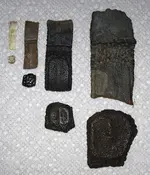Guest 1551
Hero Member
- #1
Thread Owner

Here's a photo comparing some different armadillo osteoderms:
View attachment 1609226
To the far left is a modern nine banded armadillo (Dasypus novemcinctus) flex osteoderm (top) and normal osteoderm (bottom). To the right of that is a larger extinct cousin of the modern armadillo from the same genus, Dasypus bellus. The next osteoderms are from the giant armadillo, Holmesina. The far right and largest is Holmesina septentrionalis, and the smaller of the two giant armadillo osteoderms is Holmesina floridanus.

